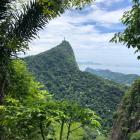Rio de Janeiro is universally recognized for its unique urban natural environment, with rich forests, mountain peaks, and beaches constituting its landscape. The city’s relationship with its green areas is intrinsic, due principally to the fact that two of the most extensive urban forests in the world are located there: the forests of the Tijuca and the Pedra Branca massifs (Figure 1). During the nineteenth century, however, the city underwent intense transformation. It was essentially in Rio de Janeiro, from the 1840s onwards, that the first initiatives in forest conservation and the rejuvenation of degraded areas materialized in Brazil, consisting of the planting of the Paineiras Forest, the Tijuca Forest, and other national forests. From these initiatives, there emerged a well-structured forestry policy and a schedule of foundational practices for tropical forestry.
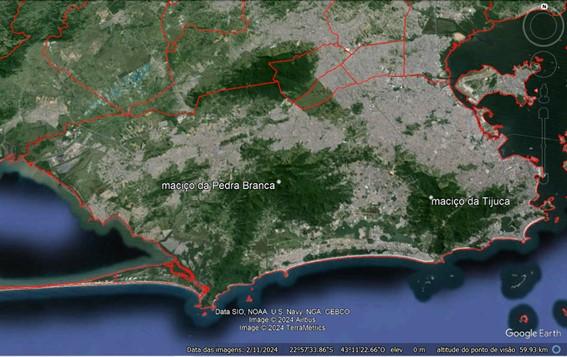
Fig. 1. Satellite image obtained from Google Earth highlighting the coastal massifs of the city of Rio de Janeiro: Tijuca and Pedra Branca. Currently, their forests are protected by two conservation units: Tijuca National Park and Pedra Branca State Park, respectively.
Fig. 1. Satellite image obtained from Google Earth highlighting the coastal massifs of the city of Rio de Janeiro: Tijuca and Pedra Branca. Currently, their forests are protected by two conservation units: Tijuca National Park and Pedra Branca State Park, respectively.
© 2024 Google Earth
The copyright holder reserves, or holds for their own use, all the rights provided by copyright law, such as distribution, performance, and creation of derivative works.
Cyclical water shortages have been part of the routine for the citizens of Rio de Janeiro since its founding (Figure 2). As the city expanded, practically all the necessary resources were extracted from forests: charcoal, firewood, and wood for construction—a fact that only worsened water shortages by impacting springs and water courses. This concern led Dom João VI, King of the United Kingdom of Portugal, Brazil, and the Algarves, from 1816 to 1822, to demand, in 1817, the protection of the riparian forests of the Carioca River, the city’s principal source of water in that period. Thus, he enacted the “Decree prohibiting the cutting of trees, timber, firewood, and brush in all land surrounding the springs of the Carioca River.”
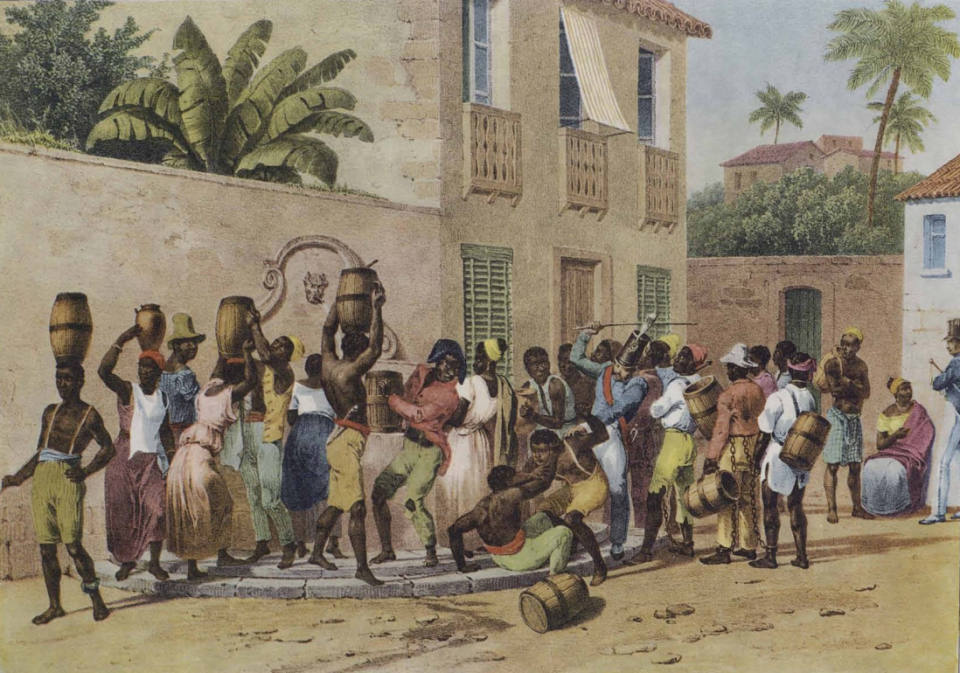
Fig. 2. Painting by Johann Moritz Rugendas, 1835, illustrating the work of slaves in distributing water. The city’s population had more than doubled with the arrival of the Portuguese court in Brazil in 1808, necessitating the canalization of waters, especially from the Carioca and Maracanã rivers. Aqueducts were built to bring water to the city, as well as fountains and drinking fountains to ensure access and distribution to citizens.
Fig. 2. Painting by Johann Moritz Rugendas, 1835, illustrating the work of slaves in distributing water. The city’s population had more than doubled with the arrival of the Portuguese court in Brazil in 1808, necessitating the canalization of waters, especially from the Carioca and Maracanã rivers. Aqueducts were built to bring water to the city, as well as fountains and drinking fountains to ensure access and distribution to citizens.
Colorized lithograph by Johann Moritz Rugendas. From Johann Moritz Rugendas, Malerische Reise in Brasilien. Facsimile of the first edition. Stuttgart: Daco-Verlag Bläse, 1986.
Courtesy of Senado Federal do Brasil. Click here to view source.
 This work is licensed under a Creative Commons Public Domain Mark 1.0 License.
This work is licensed under a Creative Commons Public Domain Mark 1.0 License.
Coffee cultivation on the city’s forested slopes in the first half of the nineteenth century exacerbated the crisis: thousands of hectares of forests were cut and burned to make way for coffee growing (Figure 3), whose importance to the economy proved so significant that the coffee plant appeared on the Empire’s flag, resplendent with fruiting branches.
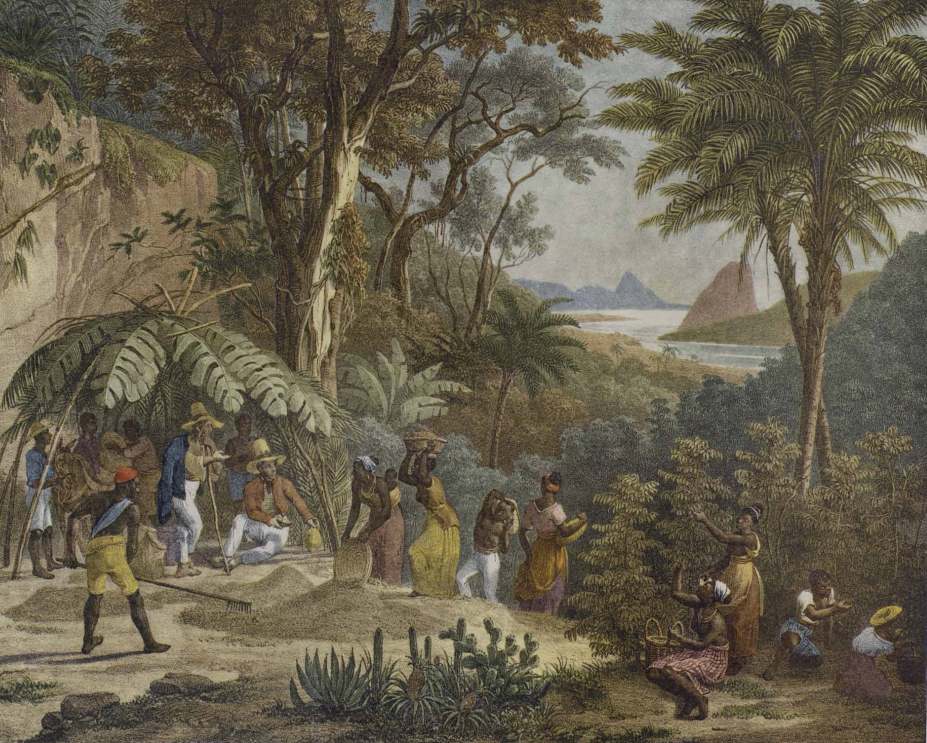
Fig. 3. Painting by Rugendas, 1835, illustrating the coffee harvest in the Tijuca Massif. The iconic landscape of the city—with its mountains and inselbergs, and Guanabara Bay—can be seen in the background. In the foreground, the different stages of coffee production stand out: from harvesting to drying the beans, in addition to their transport by mules.
Fig. 3. Painting by Rugendas, 1835, illustrating the coffee harvest in the Tijuca Massif. The iconic landscape of the city—with its mountains and inselbergs, and Guanabara Bay—can be seen in the background. In the foreground, the different stages of coffee production stand out: from harvesting to drying the beans, in addition to their transport by mules.
Colorized lithograph by Johann Moritz Rugendas. From Johann Moritz Rugendas, Malerische Reise in Brasilien. Facsimile of the first edition. Stuttgart: Daco-Verlag Bläse, 1986.
Courtesy of Senado Federal do Brasil. Click here to view source.
 This work is licensed under a Creative Commons Public Domain Mark 1.0 License.
This work is licensed under a Creative Commons Public Domain Mark 1.0 License.
While forest conservation was subject to legal oversight, in practice, things only began to notably change during the 1840s, when the crown implemented urgent measures to enhance the well-being of the population. The first experimental plantings took place on the outskirts of Corcovado Mountain (Figure 4) between 1846 and 1847, and a few years later, the Paineiras Forest was officially established. During this early period, around 3,000 seedlings were planted, prioritizing species of Brazilian flora: canjerana (Cabralea canjerana [Vell.] Mart.), garapiapunha (Apuleia leiocarpa [Vogel] J.F.Macbr.), sapucaia (Lecythis sp.), and tapinhoã (Mezilaurus navalium [Allemão] Taub. ex Mez), for example.
As such, an original project was organized and implemented in 1862, which aspired to the reforestation of extensive deforested areas of the Tijuca Massif. This resulted specifically in the creation and planting of the Paineiras Forest and the Tijuca Forest. In the Tijuca Forest alone, over 33 years (1862–1894), more than 150,000 seedlings of species considered hardwood were planted: Such species were recognized for their good quality and commercial value. It is estimated that around 70 percent of these seedlings took hold, which further illustrates the enterprise’s success. The documents also reveal that more than 100 species were employed in the project, with a preference for native species of Brazilian flora, especially from the Atlantic Forest. By comparison, it is estimated that more than 30,000 seedlings were planted in the Paineiras Forest in the same period, following the same principles.
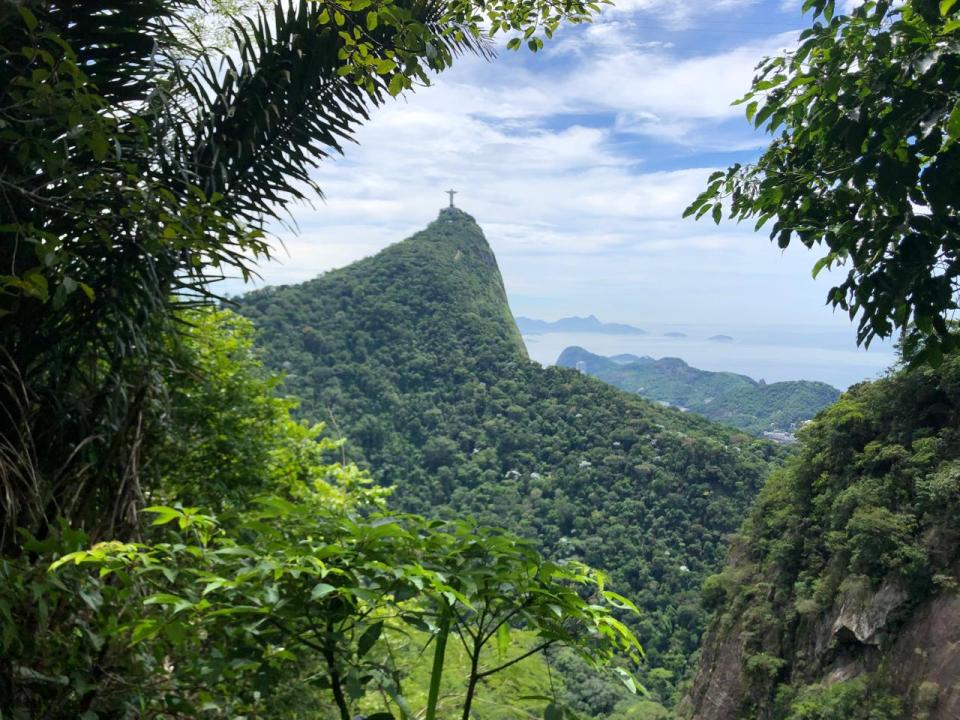
Fig. 4. Landscape of the Tijuca Massif, seen from the south side, with an emphasis on Morro do Corcovado, in the area where the “Floresta das Paineiras” was planted. Currently, this peak is home to one of the most characteristic symbols of the city of Rio de Janeiro: the statue of Christ the Redeemer with open arms over Guanabara Bay.
Fig. 4. Landscape of the Tijuca Massif, seen from the south side, with an emphasis on Morro do Corcovado, in the area where the “Floresta das Paineiras” was planted. Currently, this peak is home to one of the most characteristic symbols of the city of Rio de Janeiro: the statue of Christ the Redeemer with open arms over Guanabara Bay.
Photograph by Gabriel Paes da Silva Sales
 This work is licensed under a Creative Commons Attribution 4.0 International License.
This work is licensed under a Creative Commons Attribution 4.0 International License.
Just as noteworthy is the care administered within the different stages of the project. In the early years, seedbeds and nurseries were created to harbor seedlings in baskets—both the seedlings cultivated in the forest itself and those transplanted from neighboring forests (including the Pedra Branca Massif)—a fact that may indeed have contributed to the success of the plantings. In addition to the reforested areas and the organization of nurseries, another fact that demonstrates the success of the project was how positive decision-making enhanced the regeneration of areas deforested by coffee growing, enabling residents and visitors today to enjoy the extensive green areas that are so characteristic of the city (Figure 5).
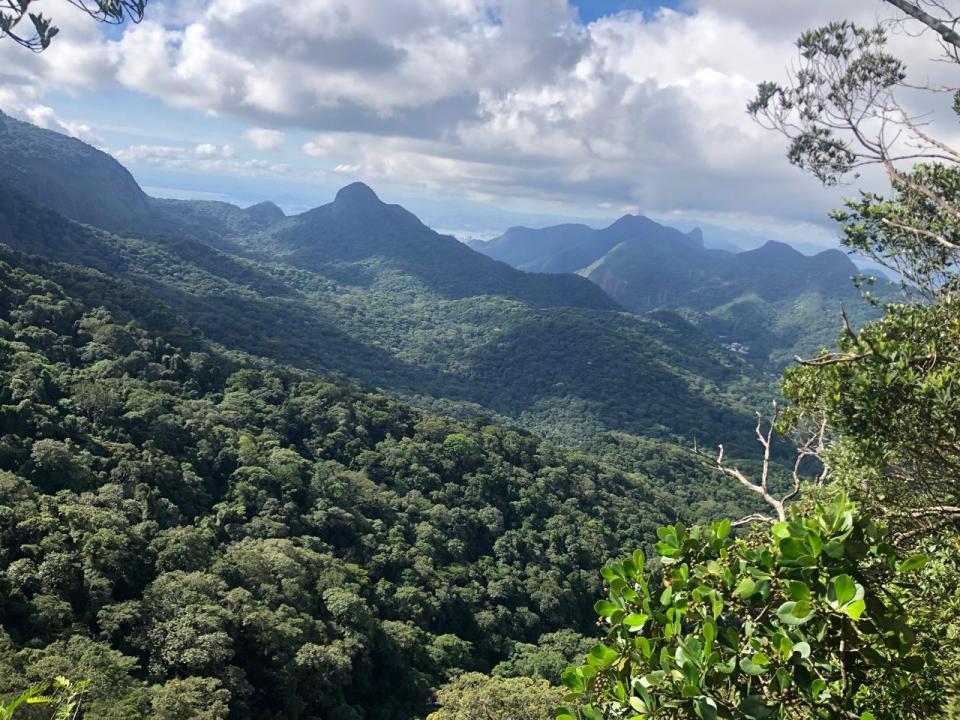
Fig. 5. Landscape of the Tijuca Massif, from the northwest side, highlighting the verdant forests resulting from past plantations of the Tijuca Forest. The reforestation efforts, in the nineteenth century, of the Tijuca Forest, the Paineiras Forest, and others in this massif allowed the regeneration of extensive forested areas that today provide various valuable ecosystem services to the city.
Fig. 5. Landscape of the Tijuca Massif, from the northwest side, highlighting the verdant forests resulting from past plantations of the Tijuca Forest. The reforestation efforts, in the nineteenth century, of the Tijuca Forest, the Paineiras Forest, and others in this massif allowed the regeneration of extensive forested areas that today provide various valuable ecosystem services to the city.
Photograph by Gabriel Paes da Silva Sales.
 This work is licensed under a Creative Commons Attribution 4.0 International License.
This work is licensed under a Creative Commons Attribution 4.0 International License.
The planting model that was undertaken in Rio’s mountains should have, by rights, been reproduced in other parts of Brazil; at least that was what Major Archer surmised, who was first responsible for the administration of the Tijuca Forest, as did the Baron of Bom Retiro, an essential figure of the Empire, who held the presidency of the Imperial Fluminense Institute of Agriculture. Historical documents, uncovered in this study, reveal that the initiatives in Paineiras and Tijuca are part of a broader context of imperial policy. Apparently, such ideas were not replicated in other parts of the Brazilian territory. There is, however, evidence that other “national forests” were established, which commenced in the 1880s in the Tijuca Massif itself, with the creation of the Andaraí Grande Forest and the Jacarepaguá Forest. This evidence suggests the existence of an emerging and urgent imperial policy that not only restored forest areas located in watersheds that were important for the city’s water supply, but also foresaw the potential for future exploitation of timber resources.
It can therefore be inferred that the nineteenth century was a period of profound transformations, both in the city of Rio de Janeiro and in the surrounding landscapes of the Tijuca Massif. Those transformations were largely driven by the development of sound ideas that strengthened forestry policy and promoted the emergence of tropical forestry. Today, more than 150 years after the commencement of successful forestry planning in the Tijuca Massif, we are burdened with countless questions as to the role played by the revegetation of degraded areas and ecological restoration in megadiverse countries, in the face of the accelerated and intense challenges typical of the Anthropocene.
How to cite
Sales, Gabriel Paes da Silva, and Rejan R. Guedes-Bruni. “The Planting of the First National Forests in Brazil: Forest Policy and the Emergence of Tropical Forestry in the Nineteenth Century.” Environment & Society Portal, Arcadia (Autumn 2024), no. 16. Rachel Carson Center for Environment and Society. doi:10.5282/rcc/9882.
ISSN 2199-3408
Environment & Society Portal, Arcadia
 This work is licensed under a Creative Commons Attribution 4.0 International License.
This work is licensed under a Creative Commons Attribution 4.0 International License.
2024 Gabriel Paes da Silva Sales and Rejan R. Guedes-Bruni
This refers only to the text and does not include any image rights.
Please click on an image to view its individual rights status.
- Abreu, Maurício de Almeida. “A Cidade, a Montanha e a Floresta”. In Escritos sobre Espaço e História, edited by Fania Fridman and Rogério Haesbaert. Garamond, 2014.
- Dean, Warren. A Ferro e Fogo: A História e a Devastação da Mata Atlântica Brasileira. Companhia das Letras, 1996.
- Drummond, José Augusto. “O Jardim Dentro da Máquina: Breve História Ambiental da Floresta da Tijuca”. Estudos Históricos 1, no. 2 (1988): 276–98.
- Heynemann, Claúdia Beatriz. Floresta da Tijuca: Natureza e Civilização no Rio de Janeiro – Século XIX. Rio de Janeiro: Secretaria Municipal de Cultura, Departamento Geral de Documentação e Informação Cultural, Divisão de Editoração, 1995.
- Pádua, José Augusto. “Brazil in the History of Anthropocene.” In Brazil in the Anthropocene: Conflicts between Predatory Development and Environmental Policies, edited by Liz-Rejane Issberner and Philippe Léna. Routledge, 2017.
- Pádua, José Augusto. Um sopro de destruição: pensamento político e crítica ambiental no Brasil escravista (1786–1888). Jorge Zahar Editor, 2002.
- Sales, Gabriel Paes da Silva, and Rejan R. Guedes-Bruni. “New Sources of Biological Data Supporting Environmental History of a Tropical Forest of South-Eastern Brazil”. HALAC – Historia Ambiental Latinoamericana y Caribeña 13, no. 2 (2023): 281–308.




